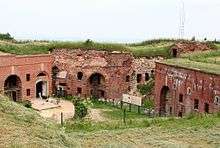Srebrna Góra, Lower Silesian Voivodeship
| Srebrna Góra | ||
|---|---|---|
| Village | ||
|
View from the fortress | ||
| ||
 Srebrna Góra | ||
| Coordinates: 50°34′34″N 16°39′45″E / 50.57611°N 16.66250°E | ||
| Country |
| |
| Voivodeship | Lower Silesian | |
| County | Ząbkowice Śląskie | |
| Gmina | Stoszowice | |
| Population (approx.) | 1,500 | |
Srebrna Góra [ˈsrɛbrna ˈɡura] (German: Silberberg) is a village in the administrative district of Gmina Stoszowice, within Ząbkowice Śląskie County, Lower Silesian Voivodeship, in south-western Poland.[1] Prior to 1945 it was in Germany.
It lies on the northern slope of the Owl Mountains range, approximately 6 kilometres (4 mi) south-west of Stoszowice, 11 kilometres (7 mi) west of Ząbkowice Śląskie, and 67 kilometres (42 mi) south-west of the regional capital Wrocław. The village has an approximate population of 1,500.
History
The silver mining area was mentioned in a 1331 deed issued by the Silesian duke Bolko II of Ziębice in 1331, a Bohemian vassal from 1336, the settlement itself in 1417. Located near the border of the Duchy of Ziębice (Münsterberg) with the Bohemian County of Kladsko on the mountain pass road to Nowa Ruda, Silberberg was often hit by military confrontations, at first by the Hussite Wars, later also by the Thirty Years' War, which left the area devastated.
In 1536 Silberberg received city rights and mining privileges, and after the Duchy of Ziębice as a reverted fief had fallen to the Bohemian Crown, the area was purchased by Bohemian (Czech) aristocrat William of Rosenberg in 1581. (William bought the town for reasons of prestige, because of the right to mint its own coins which has been tied with the town and local silver mines.) It passed to Duke Joachim Frederick of Brieg in 1599 and finally fell back to Bohemia upon the death of the last Piast duke George William of Legnica in 1675.
With most of Silesia, it was annexed by King Frederick II of Prussia after the First Silesian War in 1742.
Fort Srebrna Góra

Frederick II had a border fortress of the Prussian Army built at Silberberg, finished in 1778, which after the Napoleonic Wars served as a prison in the pre-revolutionary Vormärz era. Among the inmates was the author Fritz Reuter, arrested here from 1834 until 1837, as well as the editor Wilhelm Wolff.
The fort is one of Poland's official national Historic Monuments (Pomnik historii), as designated May 1, 2004. Its listing is maintained by the National Heritage Board of Poland.[2]
See also
References
| Wikimedia Commons has media related to Srebrna Góra. |
Coordinates: 50°34′34″N 16°39′45″E / 50.57611°N 16.66250°E
_COA.gif)